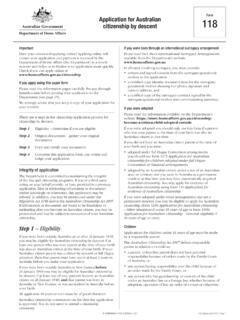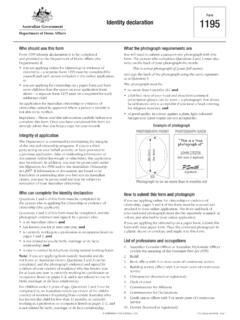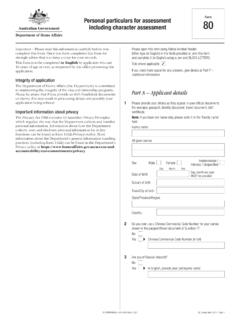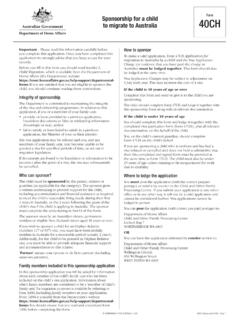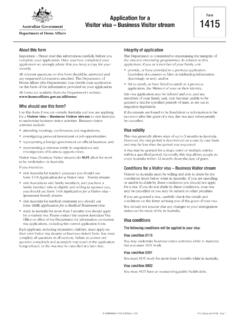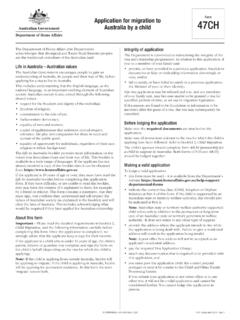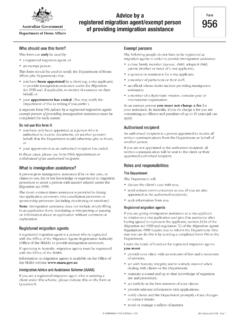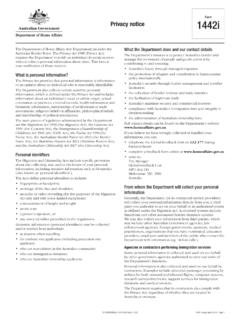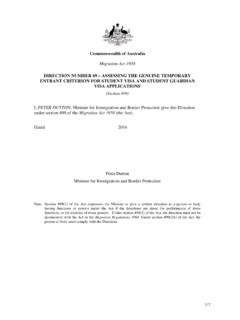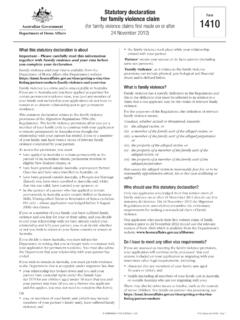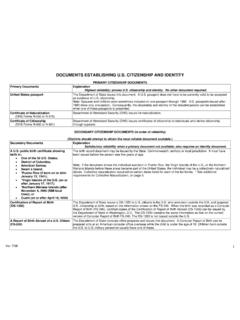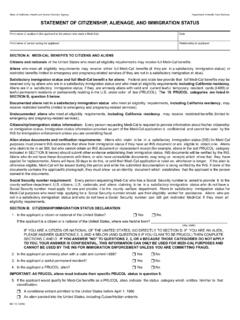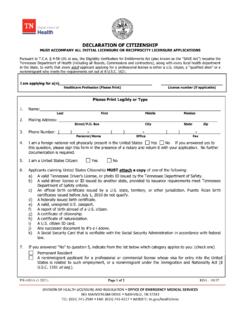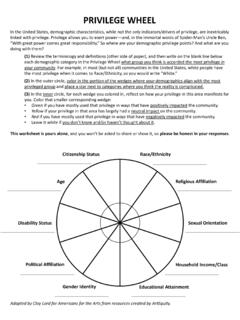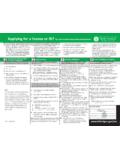Transcription of Citizenship Ceremonies Code - Home Affairs
1 Australian Citizenship Ceremonies Code Commonwealth of Australia 2019 With the exception of the Commonwealth Coat of Arms, all material presented in this publication is provided under a Creative Commons Attribution International license at This means this license only applies to material as set out in this document. The details of the relevant license conditions are available on the Creative Commons website at as is the full legal code for the CC BY license at . Use of the Coat of Arms The terms under which the Coat of Arms can be used are detailed at the Department of Prime Minister and Cabinet website Contact us Enquiries regarding the licence and any use of this document are welcome at: Media and Engagement Branch Department of Home Affairs PO Box 25 BELCONNEN ACT 2616 Part 1: Australian Citizenship Ceremonies Code 6 Legal requirements 6 Authorised presiding officer 6 Reading the preamble 6 The pledge of commitment 6 The importance of Australian Citizenship 7 Responsibilities 7 Privileges 7 What is a Citizenship ceremony?
2 8 The nature of the ceremony 9 What is the pledge of commitment? 10 Pledge 1 10 Pledge 2 10 Roles and responsibilities 10 Minister 10 The Department of Home Affairs 11 Presiding officer 12 Official guests 12 Federal Members of Parliament 13 State and Territory Members of Parliament 13 Mayors 14 Organisers 14 Conferees 14 Australian Electoral Commission 15 Guests of conferees 15 Contents Citizenship Ceremonies during election periods 16 Local council elections 16 State and Federal elections 16 Federal elections 16 Overseas Australian Citizenship Ceremonies 17 Contact the Department of Home Affairs 17 Glossary 18 Part 2: Before the ceremony 19 Scheduling Ceremonies 19 Events 20 Parliamentary sitting days 21 Planning report 22 Rescheduling Ceremonies 22 Special purpose Ceremonies 22 Organising the ceremony 23 Venue 23 Products 23 Symbols 24 Dress code 25 Seating plan 25 Gifts and entertainment 26 Incorporating Aboriginal and Torres Strait Islander elements 27 Invitations 28 Children 29 Children under 16 years of age 29 Children aged 16 years or over 29 Pledge verification list 30 Media, photos and consent forms 30 Media 30 Photographs 31 Consent forms 31 Suggested program for ceremony 32 Before the ceremony checklist 33 Part 3.
3 At the ceremony 34 Registration 34 Identity verification 34 Welcome to Country/Acknowledgement of Country 35 If the Minister attends 36 Speeches 36 The Minister/Minister s Representative 36 Inviting official guests to speak 36 Suggested length and content of speeches 37 Preamble 38 The Pledge of Commitment 38 Pledge 1 38 Pledge 2 38 Children 39 Holy books and scriptures 39 Australian Citizenship certificates 39 Presenting Australian Citizenship certificates to conferees 39 Altering Citizenship certificates 40 If details are incorrect on Australian Citizenship certificates 40 The Australian Citizenship Affirmation 41 Australian electoral enrolment 42 At the ceremony checklist 43 Part 4: After the ceremony 44 Returning the pledge verification list 44 Privacy 45 Disclosing names and addresses of new citizens 45 Returning Australian Citizenship certificates 46 After the ceremony checklist 46 The Australian Citizenship Ceremonies Code (the Code) follows the Australian Citizenship Act 2007 (the Citizenship Act) and sets out the legal and other requirements for conducting Citizenship Ceremonies as well as the roles and responsibilities for those involved in Citizenship Ceremonies .
4 The Code provides guidance to organisations to help plan and conduct Citizenship Ceremonies . The Code is structured in four parts, providing relevant responsibilities and advice for before, during and after the ceremony. This is prefaced with a quick guide, outlining the key ceremony information and background. The resources in the Code are reviewed regularly to ensure that information is up to date. This version of the Code was published in August 2019. Legal requirements There are three legal requirements under the Citizenship Act that must be strictly adhered to when conducting Citizenship Ceremonies : 1. an authorised presiding officer 2. reading the preamble 3. the pledge of commitment Authorised presiding officer It is a legal requirement that the presiding officer is authorised by the Australian Government minister responsible for Citizenship matters.
5 Authorisation is given to Australian citizens only and is specific to a position or person. Further information on the role of the presiding officer is at page 12. Reading the preamble It is a legal requirement that the presiding officer must read aloud to the conferees the preamble for Citizenship Ceremonies (found at Schedule 1 of the Australian Citizenship Regulation 2016). The pledge of commitment It is a legal requirement that most conferees 16 years of age and over (at the time of application) make the pledge aloud before an authorised presiding officer. 6 Australian Citizenship Ceremonies Code PART 1 Australian Citizenship Ceremonies Code Australian Citizenship is an important common bond for all Australians, whether Australians by birth or by choice, and lies at the heart of a unified, cohesive and inclusive Australia.
6 It is a unique symbol of formally identifying with Australia, acknowledging responsibilities and conferring significant privileges that allow people to participate fully in the community. Responsibilities As an Australian citizen you must: obey the laws and fulfil your duties as an Australian citizen vote in federal and state or territory government elections, and in a referendum serve on a jury if called to do so defend Australia should the need arise. Privileges As an Australian citizen you have the right to: vote in federal, state or territory, and local government elections, and in a referendum apply for work in the Australian Public Service or in the Australian Defence Force seek election to parliament apply for an Australian passport receive help from Australian officials while overseas register children born to you overseas, after you become an Australian citizen, as Australian citizens by descent.
7 Australian Citizenship Ceremonies Code 7 The presiding officer generally reads the pledge aloud line by line for the conferees to repeat. This is referred to as administering the pledge. Further information on the pledge of commitment is at page 10. The importance of Australian Citizenship What is a Citizenship ceremony? The final legal step in the acquisition of Australian Citizenship , for most people, is to make the pledge of commitment at an Australian Citizenship ceremony. At the Citizenship ceremony, conferees pledge that they share Australia s democratic beliefs and respect the rights and liberties of the people of Australia. Our democratic beliefs: parliamentary democracy the rule of law living peacefully respect for all individuals regardless of background compassion for those in need.
8 Our freedoms: freedom of thought, speech and expression freedom of association freedom of religion and secular government. Our equality standing: equality before the law equality of genders equality of opportunity. Citizenship Ceremonies are public, ceremonial occasions, which fulfil legal requirements prescribed by the Citizenship Act and the Australian Citizenship Regulation 2016. Citizenship Ceremonies also provide an important opportunity to formally welcome new citizens as full members of the Australian community. Since the early 1950s, local government councils have conducted the majority of Citizenship Ceremonies on behalf of the Department responsible for Citizenship .
9 Local government councils are well placed for this welcoming role as the arm of government closest to new citizens and the communities to which they belong. Representatives of all three levels of government (federal, state or territory and local), community leaders, Aboriginal and Torres Strait Islander leaders, and guests of the conferees are invited to attend. After the conferral, Citizenship Ceremonies often include the Australian Citizenship Affirmation, giving everyone present an opportunity to publicly affirm their loyalty to Australia in a similar way to the new citizens. 8 Australian Citizenship Ceremonies Code The nature of the ceremony To reflect the significance of the occasion, Citizenship Ceremonies should be formal and meaningful occasions conducted with dignity, respect and ceremony.
10 They should be designed to impress upon conferees the responsibilities and privileges of Australian Citizenship . They should warmly welcome new citizens as full members of the community. Conferees are the most important people at the ceremony and the focus of attention should be on them. Citizenship Ceremonies must be non-commercial, apolitical, bipartisan and secular. They must not be used as forums for political, partisan or religious expression, for the distribution of political material or the sale of souvenirs. As conferees come from diverse cultures, it is important to be aware and respectful of cultural differences. Australian Citizenship Ceremonies Code 9 What is the pledge of commitment?
